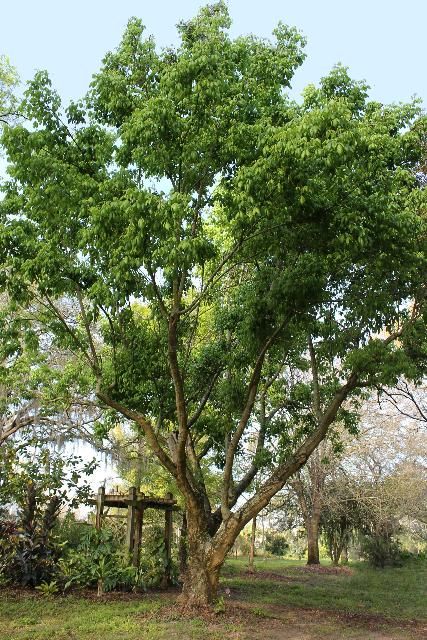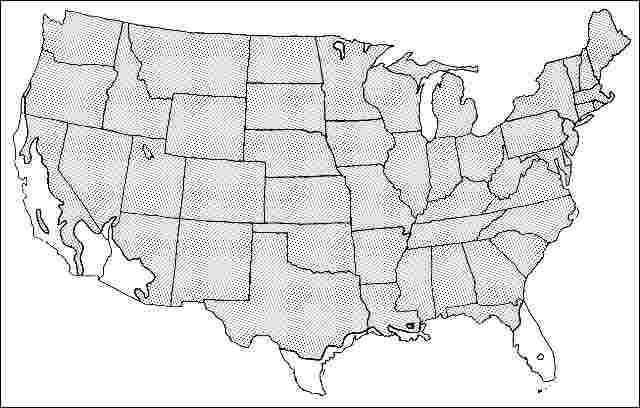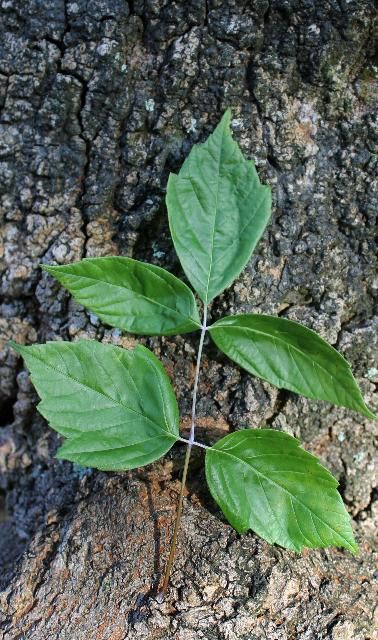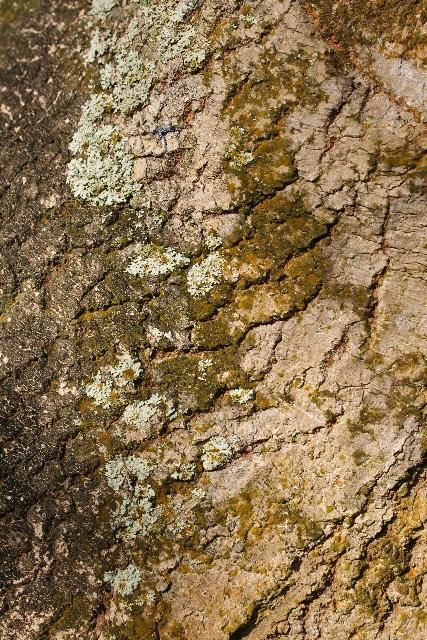Introduction
Boxelder forms a 40-to 50-foot-tall rounded canopy of very light green foliage. The boxelder is an undesirable tree for many urban situations and in some cities, planting it may be illegal. The undesirable characteristics are brittle, weak wood, short life, susceptibility to boxelder bug, and trunk decay. But the tree will grow just about anywhere and therefore it may have uses due to its adaptability. The best thing about the tree is that it will grow on adverse sites where more desirable trees may not. If you use the tree, plant it for its quick growth, but interplant with more desirable trees to provide for a lasting tree canopy. Boxelder is native along streambanks over a wide area of the United States, grows along flood plains, and naturalizes quickly on disturbed sites. It may be best to restrict planting to these areas. It is tolerant of drought and was planted as a shelter-belt tree.

Credit: Gitta Hasing, UF/IFAS
General Information
Scientific name: Acer negundo
Pronunciation: AY-ser nuh-GUHN-doe
Common name(s): boxelder, Manitoba maple
Family: Sapindaceae
USDA hardiness zones: 3A through 8B (Fig. 5)
Origin: native to North and Central America, from Canada to Guatemala
UF/IFAS Invasive Assessment Status: native
Uses: screen; reclamation; Bonsai

Description
Height: 40 to 50 feet
Spread: 30 to 40 feet
Crown uniformity: symmetrical
Crown shape: round
Crown density: dense
Growth rate: fast
Texture: medium
Foliage
Leaf arrangement: opposite/subopposite
Leaf type: odd-pinnately compound; made up of 3-5 leaflets, occasionally 7-9
Leaf margin: serrate, lobed
Leaf shape: ovate, lanceolate
Leaf venation: reticulate, pinnate
Leaf type and persistence: deciduous
Leaf blade length: leaflets 2 to 4 inches
Leaf color: green on top, paler green underneath
Fall color: yellow, orange
Fall characteristic: showy

Credit: Gitta Hasing, UF/IFAS
Flower
Flower color: yellow green
Flower characteristics: not showy; emerges in clusters on racemes
Flowering: early spring, prior to new leaves

Credit: Gitta Hasing, UF/IFAS
Fruit
Fruit shape: elongated 2-winged samara
Fruit length: 1-1 1/2 inch
Fruit covering: dry or hard
Fruit color: brownish-tan
Fruit characteristics: attracts squirrels/mammals; showy; fruit/leaves a litter problem
Fruiting: matures in mid-summer
Trunk and Branches
Trunk/branches: branches droop; not showy; typically one trunk; no thorns
Bark: gray to light brown and thin, with shallow interlacing ridges
Pruning requirement: needed for strong structure
Breakage: Susceptible to breakage
Current year twig color: green, brown
Current year twig thickness: medium
Wood specific gravity: unknown

Credit: Gitta Hasing, UF/IFAS
Culture
Light requirement: full sun, partial sun or partial shade
Soil tolerances: clay; sand; loam; alkaline; acidic; extended flooding; well-drained
Drought tolerance: high
Aerosol salt tolerance: moderate
Other
Roots: can form large surface roots
Winter interest: no
Outstanding tree: no
Ozone sensitivity: sensitive
Verticillium wilt susceptibility: susceptible
Pest resistance: sensitive to pests/diseases
Use and Management
The tree is sometimes listed in catalogs as ash leaved maple and the numerous, attractive seeds are very popular with squirrels. Fall color can be vivid yellow in the north to muted orange-brown in the southern part of its range. There is occasional good fall color in the south. A nice plant for naturalized areas, particularly if the soil is wet, or the pH is alkaline. It is probably best used in these areas to help stabilize stream beds and colonize reclaimed land. Do not plant it as a street tree.
The cultivars of boxelder are more ornamental but still share the tree's undesirable characteristics: 'Aureo-variegatum'—leaves bordered in gold; 'Flamingo'—variegated leaves with pink margins, somewhat available; 'Variegatum'—leaves bordered in white; 'Auratum'—leaves gold; 'Elegantissima'—yellow leaf variegations.
Pests
Leaf stalk borer and petiole borer cause the same type of injury. Both insects bore into the leaf stalk just below the leaf blade. The leaf stalk shrivels, turns black, and the leaf blade falls off. The leaf drop may appear heavy but serious injury to a healthy tree is rare.
Gall mites stimulate the formation of growths or galls on the leaves. The galls are small but can be so numerous that individual leaves curl up. The most common gall is bladder gall mite found on silver maple. The galls are round and at first green but later turn red, then black, then dry up. Galls of other shapes are seen less frequently on other types of maples. Galls are not serious, so chemical controls are not needed.
Crimson erineum mite is usually found on silver maple and causes the formation of red fuzzy patches on the lower leaf surfaces. The problem is not serious so control measures are not suggested.
Aphids infest maples, usually Norway maple, and may be numerous at times. High populations can cause leaf drop. Another sign of heavy aphid infestation is honey dew on lower leaves and objects beneath the tree. Aphids are controlled by spraying or they may be left alone. If not sprayed, predatory insects will bring the aphid population under control.
Boxelder bug infests boxelders, primarily the female trees. The insect does no serious harm to the tree but is a nuisance when it overwinters in homes. The insects are red and black and can be vacuumed up when seen in the house. Control measures include removal of female boxelder trees. If boxelders are growing in adjacent yards removing your tree may not be effective.
Scales are an occasional problem on maples. Perhaps the most common is cottony maple scale. The insect forms a cottony mass on the lower sides of branches. Scales are usually controlled with horticultural oil sprays. Scales may also be controlled with well-timed sprays to kill the crawlers.
If borers become a problem it is an indication the tree is not growing well. Controlling borers involves keeping trees healthy. Chemical controls of existing infestations are more difficult. Proper control involves identification of the borer infesting the tree then applying insecticides at the proper time.
Diseases
Anthracnose is more of a problem in rainy seasons. The disease resembles, and may be confused with, a physiological problem called "scorch". The disease causes light brown or tan areas on the leaves. Anthracnose may be controlled by fungicides sprayed on as leaves open in the spring. Two additional sprays at two-week intervals will be needed. The disease is most common on sugar and silver maples and boxelder. Other maples may not be affected as severely. Sprays may need to be applied by a commercial applicator having proper spray equipment.
Verticillium wilt symptoms are wilting and death of branches. Infected sapwood will be stained a dark or olive green, but staining can't always be found. If staining can not be found, do not assume the problem is not verticillium wilt. Severely infected trees probably can't be saved. Lightly infected trees showing only a few wilted branches may be pulled through. Fertilize and prune lightly infected trees. This treatment will not cure the problem but may allow the tree to outgrow the infection. Girdling roots will cause symptoms which mimic verticillium wilt.
Girdling roots grow around the base of the trunk rather than growing away from it. As both root and trunk increase in size, the root chokes the trunk. Girdling roots are detected by examining the base of the trunk. The lack of trunk flare at ground level is a symptom. The portion of the trunk above a girdling root does not grow as rapidly as the rest so may be slightly depressed. The offending root may be on the surface or may be just below the sod. The tree crown shows premature fall coloration and death of parts of the tree in more serious cases. If large portions of the tree have died it may not be worth saving. Girdling roots are functional roots so when removed a portion of the tree may die. When the girdling root is large the treatment is as harmful as the problem. After root removal, follow-up treatment includes watering during dry weather. The best treatment for girdling roots is prevention by removing or cutting circling roots at planting or as soon as they are detected on young trees.
Tar spot and a variety of leaf spots cause some concern among homeowners but are rarely serious enough for control.
Reference
Koeser, A. K., Hasing, G., Friedman, M. H., and Irving, R. B. 2015. Trees: North & Central Florida. University of Florida Institute of Food and Agricultural Sciences.
